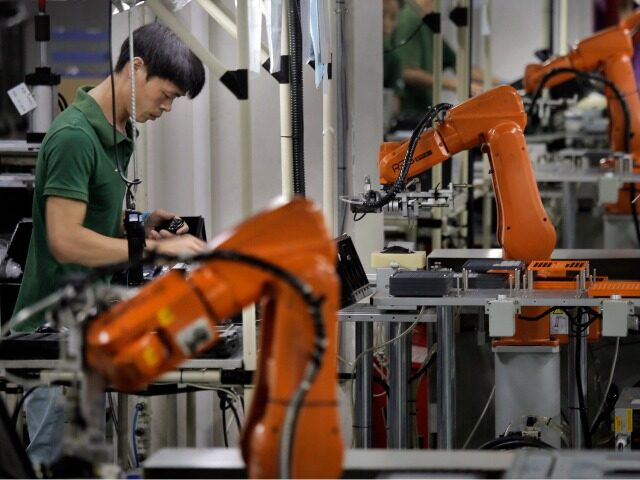Beijing Academy of Military Sciences researcher Zhao Xun published an article in Chinese Communist Party media on Monday warning that China’s current model of technology and weapons development is “unsustainable” due to Western sanctions, so China must become more self-reliant by funding more research and reducing bureaucratic red tape.
Zhao warned against continuing “the old path of following and imitating others for the development of our military’s weapons and equipment,” a euphemistic reference to China’s decades of aggressive technology theft.
In the most delicate manner possible, Zhao cautioned that restrictions on exports of advanced electronics from the U.S., Europe, and Japan — especially top-shelf semiconductors and “dual use” tech that could have military applications — would make it increasingly difficult for China to poach the “key and core technologies” it needs to meet its goals of military modernization.
Zhao’s paper also advised Beijing to lock down supplies of “raw materials, essential components, and various basic electromechanical products” instead of relying too heavily on foreign imports.
“On the surface, future high-end and large-scale wars would be battles between various types of ammunition and various weapons systems, but the real decisive factor for victory would be the supply and support chain behind it,” he wrote.
Again, stepping carefully to avoid bruising Politburo egos, Zhao criticized “shortcomings in management concepts and methods” as one reason China is behind in tech development.
China’s drive for military modernization is one of the most ambitious such programs ever undertaken, given the size of the People’s Liberation Army (PLA) and the poor position China began in.
The Council on Foreign Relations (CFR) contends that U.S. military performance in the Gulf War frightened Chinese leadership into thinking its forces were not prepared to fight a modern war, particularly in theaters where China’s legendary advantage in numbers would be less important — such as invading an island heavily defended by far more advanced military technology.
Military modernization did not kick into high gear until the current dictator, Xi Jinping, came to power in 2012. His immediate predecessor talked about updating the PLA, but Xi made it happen. He also restructured the military so it could more effectively utilize 21st Century technology — or, from another point of view, so that hidebound military leaders would have no choice but to upgrade their tactics and hardware in order to make Xi’s new organizational plans work.
Military modernization was a major driver behind the explosive growth of China’s state-owned enterprises (SOE) over the past decade. SOEs in the naval, aviation, and cyber warfare industries have particularly benefited, with some of them adding billions of dollars in revenue.
A highly visible sign of China’s success at upgrading its military technology is the artificially enhanced and heavily weaponized reefs and islands claimed by Beijing in the South China Sea. With impressive speed, some of these land features were dramatically enlarged and outfitted with military airfields — some big enough to handle nuclear-capable bombers — and top-of-the-line missile systems, effectively turning them into the stationary equivalent of an aircraft carrier battle group.
Some Western military analysts were alarmed when the Chinese Communist Party rolled out a military modernization timetable that called for major benchmarks to be reached by 2027 — a much faster pace than previously called for and uncomfortably close to the end of Xi’s unprecedented third term in power.
This spurred fears that 2027 would be the year China finally felt confident enough to attack Taiwan.
The Center for Strategic and International Studies (CSIS) argued in December 2021 that the 2027 timetable was vague and largely symbolic, and China’s actual deadline for achieving technological parity with the U.S. military remains closer to “mid-century,” with a nominal deadline of 2035 for bringing every branch of the PLA up to modern standards.
Zhao’s paper essentially argues that China’s drive to hit those modernization benchmarks has left it vulnerable to supply chain issues — much as globalization gave China an uncomfortable degree of control over Western military supply chains — and that changing Western attitudes will make it harder for Beijing to secure the technology it needs to take those difficult last steps toward full parity.
Perhaps one of the best reasons for hoping China is not quite ready to pull the trigger on invading Taiwan is that China, like the rest of the world, is heavily reliant upon the Taiwanese semiconductor industry. Until China’s domestic semiconductor design and production are fully up to speed, it cannot afford to bomb Taiwan’s factories into rubble.

COMMENTS
Please let us know if you're having issues with commenting.